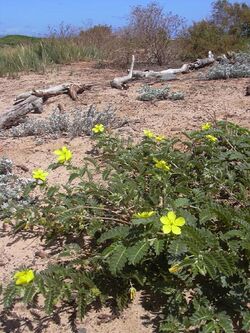Biology:Tribulus
| Tribulus | |
|---|---|

| |
| Tribulus cistoides in flower | |
| Scientific classification | |
| Kingdom: | Plantae |
| Clade: | Tracheophytes |
| Clade: | Angiosperms |
| Clade: | Eudicots |
| Clade: | Rosids |
| Order: | Zygophyllales |
| Family: | Zygophyllaceae |
| Genus: | Tribulus L.[1][2] |
Tribulus is a genus of plants in the family Zygophyllaceae and found in diverse climates and soils worldwide from latitudes 35°S to 47°N.[3][4] The best-known member is T. terrestris (puncture vine), a widespread invasive species and weed.[4]
Tribulus species are perennial, but some grow as annuals in colder climates.[4] The leaves are opposite and compound. The flowers are perfect (hermaphroditic) and insect-pollinated, with fivefold symmetry. The ovary is divided into locules that are in turn divided by "false septa" (the latter distinguish Tribulus from other members of its family).
Some species are cultivated as ornamental plants in warm regions. Some, notably T. cistoides, T. longipetalus, T. terrestris, and T. zeyheri, are considered weeds. Tribulus omanense is the national flower of Dubai.[5] Thirteen species of Tribulus are accepted by The Plant List, but there are many names still unresolved and needing further study.[4]
List of accepted species
(According to Plants of the world online[3])
- Tribulus adelacanthus R.M.Barker
- Tribulus arabicus Hosni
- Tribulus astrocarpus F.Muell.
- Tribulus bimucronatus Viv.
- Tribulus cistoides L.
- Tribulus cristatus C.Presl
- Tribulus echinops Kers
- Tribulus eichlerianus K.L.Wilson
- Tribulus excrucians Wawra
- Tribulus forrestii F.Muell.
- Tribulus hirsutus Benth.
- Tribulus hystrix R.Br.
- Tribulus incanus Hosni
- Tribulus kaiseri Hosni
- Tribulus macrocarpus F.Muell. ex Benth.
- Tribulus macropterus Boiss.
- Tribulus megistopterus Kralik
- Tribulus micrococcus Domin
- Tribulus minutus Leichh. ex Benth.
- Tribulus mollis Ehrenb. ex Schweinf.
- Tribulus occidentalis R.Br.
- Tribulus omanense Hosni
- Tribulus parvispinus C.Presl
- Tribulus pentandrus Forssk.
- Tribulus platypterus Benth.
- Tribulus ranunculiflorus F.Muell.
- Tribulus securidocarpus Engl.
- Tribulus spurius Kralik
- Tribulus suberosus H.Eichler ex R.M.Barker
- Tribulus subramanyamii P.Singh, G.S.Giri & V.Singh
- Tribulus terrestris L.
- Tribulus zeyheri Sond.
Uses
T. terrestris has been cultivated to inhibit soil erosion and to improve soil moisture, texture, and water-holding capability in deserts and barren lands.[4] Although T. terrestris extracts have been used in traditional medicine and as a dietary supplement for bodybuilders, there is no high-quality clinical evidence that it is effective or safe for these purposes.[4][6]
References
- ↑ "Tribulus". Australian Plant Name Index (APNI), IBIS database. Centre for Plant Biodiversity Research, Australian Government. https://biodiversity.org.au/nsl/services/rest/name/apni/60410.
- ↑ Linnaeus, C. (1753). Species Plantarum. 1. pp. 386.
- ↑ 3.0 3.1 "Tribulus L.". Plants of the world online: Royal Botanic Gardens, Kew. 2019. https://powo.science.kew.org/taxon/urn:lsid:ipni.org:names:41747-1. Retrieved 18 June 2019.
- ↑ 4.0 4.1 4.2 4.3 4.4 4.5 "Tribulus terrestris (puncture vine)". CABI. 8 November 2018. https://www.cabi.org/isc/datasheet/54447. Retrieved 27 July 2019.
- ↑ "Types of Flowers in Dubai". gardenguides.com. http://www.gardenguides.com/121544-types-flowers-dubai.html. Retrieved June 7, 2014.
- ↑ Pokrywka, Andrzej; Obmiński, Zbigniew; Malczewska-Lenczowska, Jadwiga; Fijatek, Zbigniew; Turek-Lepa, Ewa; Grucza, Ryszard (2014-07-08). "Insights into supplements with Tribulus terrestris used by athletes". Journal of Human Kinetics 41 (1): 99–105. doi:10.2478/hukin-2014-0037. ISSN 1899-7562. PMID 25114736.
External links
- Tribulus in BoDD – Botanical Dermatology Database
- Technical description of Zygophyllaceae from The Families of Flowering Plants, L. Watson and M. J. Dallwitz
Wikidata ☰ Q1017217 entry
 |



